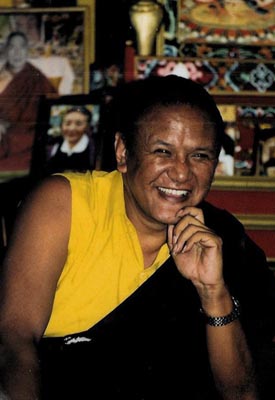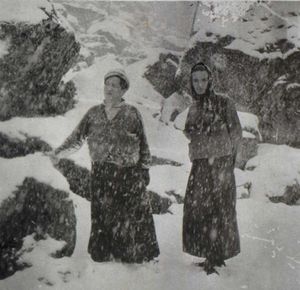Orgyen Tobgyal Rinpoche: Difference between revisions
No edit summary |
|||
| Line 54: | Line 54: | ||
==External links== | ==External links== | ||
*{{LH|tibetan-masters/living-masters/orgyen-tobgyal|Orgyen Tobgyal Series on Lotsawa House}} | *{{LH|tibetan-masters/living-masters/orgyen-tobgyal|Orgyen Tobgyal Series on Lotsawa House}} | ||
*[http://all-otr.org/ | *[http://all-otr.org/ all-otr.org: website dedicated to Orgyen Tobgyal Rinpoche's teachings] | ||
* The Life of [[Chokgyur Dechen Lingpa|Chokgyur Lingpa]], by Orgyen Tobgyal Rinpoche, Rangjung Yeshe Publications. [http://www.rangjung.com/authors/Chokgyur_Lingpa_Life.pdf Download as PDF] | * The Life of [[Chokgyur Dechen Lingpa|Chokgyur Lingpa]], by Orgyen Tobgyal Rinpoche, Rangjung Yeshe Publications. [http://www.rangjung.com/authors/Chokgyur_Lingpa_Life.pdf Download as PDF] | ||
[[Category: Contemporary Teachers]] | [[Category: Contemporary Teachers]] | ||
[[Category: Nyingma Teachers]] | [[Category: Nyingma Teachers]] | ||
Revision as of 06:58, 31 August 2015

Orgyen Tobgyal Rinpoche (Tib. ཨོ་རྒྱན་སྟོབས་རྒྱལ་རིན་པོ་ཆེ་, Wyl. o rgyan stobs rgyal rin po che) was born in 1951 in Nangchen region of Kham in Eastern Tibet. He is the son of the Third Neten Chokling Rinpoche. Although he is known as Gyalchen Tulku, the activity emanation of Taksham Nüden Dorje, he was not formally recognised as a tulku—incarnate lama—in his younger years, because it was said that this would create obstacles to his life. He is the elder brother of Khyentse Yeshe Rinpoche, Jamyang Gyaltsen and Dzigar Kongtrul Rinpoche and is affectionately called Abu Rinpoche (Abu meaning 'older brother' in the Kham dialect of Tibetan). At the end of the 1950s he left Tibet and went to Sikkim with his parents where he lived for a few years. People say that he used to follow his father wherever he went. In 1967 Chokling Rinpoche started the Tibetan settlement of Bir in Himachal Pradesh, North East India. It was on the way from Delhi to Bir that His Eminence died tragically in a car accident in 1973.
After the passing away of his father, Rinpoche took care of his monastery—Pema Ewam Chögar Gyurme Ling Monastery—in Bir. He raised the young reincarnation of his father, the 4th Neten Chokling Rinpoche, before passing over to him in 2004 full responsibility for a monastery that had become famous throughout the Tibetan world, particularly among the Nyingma school, for its expertise in elaborate Vajrayana rituals, Rinpoche's specialty.
Rinpoche also attended Dilgo Khyentse Rinpoche for many years, and it was with him that he first went to the West. After he first taught in Dordogne, France, at Pema Wangyal Rinpoche's centre, his mother heard that his teachings had been recorded, and asked for the tapes. When she listened to them, she was amazed at her son's knowledge, because she had never really seen him study. Rinpoche is well known for his incredible memory and the depth of his knowledge, particularly in the field of Vajrayana practices and rituals, and history.

Between 2004 and 2006 Rinpoche went twice to Tibet in order to rebuilt the monastery of his father, Neten Gön. Orgyen Tobgyal Rinpoche is also a Member of the Tibetan Parliament for the region of Kham, first elected in 2000 and reelected in 2005, and has a reputation as a formidable orator. Nowadays Rinpoche still lives in Bir, and travels occasionally to Europe, America, and Taiwan.
Along with the monks of his monastery, Orgyen Tobgyal Rinpoche has been a regular visitor to Lerab Ling and Rigpa centres since 1996, where he has taught on many aspects of the Vajrayana, and led many elaborate practices. He has also been closely involved in every phase of the building of the temple at Lerab Ling and has himself presided over many of the spiritual practices that are an integral part of the building process.
Teachings Given to the Rigpa Sangha
- Berkeley, 13-15, 16-18 & 20-22 September 1996, Lamrim Yeshe Nyingpo
- Lerab Ling, 20-21 August 1997, kyerim
- Lerab Ling, 26 July 1998, kyerim
- Lerab Ling, 26 & 28 July 1998, Chimé Pakmé Nyingtik
- San Francisco, 30 October-5 November 1998, Lamrim Yeshe Nyingpo
- Lerab Ling, 29 July 1999, 'Kyerim, Dzogrim and the Six Yogas'
- Lerab Ling, 23 July 2006, how to do retreat
- Lerab Ling, 25 August 2008, the Rimé tradition
- Lerab Ling, 13 May 2009, Chimé Pakmé Nyingtik
- Rigpa centre, Levallois, France, 29 May 2009, Tendrel Nyesel
- Lerab Ling, 21 & 26 July 2010, Dilgo Khyentse Rinpoche
- Lerab Ling, 1-7 August 2010, Lamrim Yeshe Nyingpo, Vol. 1, Section One, 'Prologue and Teachings on the Title, The Sign Script, and The Homage' (Chapters 1-3)
- Lerab Ling, 30 July-7 August 2011, Lamrim Yeshe Nyingpo, Vol. 1, Section Two, 'The Setting, The Circumstances, The Four Vajra Syllables, The Five Perfections and Instructions to Retain the Teaching, The Meaning of the Ground' (Chapters 4-8)
- Rigpa Berlin centre, 18 August 2011, Heart Advice by Jamyang Khyentse Chökyi Lodrö
- Rigpa centre, Levallois, France, 25 August 2011, A Beautiful String of Jewels—Jamyang Khyentse Chokyi Lodro's Heart Advice to Khandro Tséring Chödrön. Text available here
- Lerab Ling, 17-22 August 2012, Lamrim Yeshe Nyingpo, Vol. 1, Section Two cont'd & Section Three (Chapters 8-13, up to page 127)
- Lerab Ling, 27 July-5 August 2014, teaching on the Seven Line Prayer using Mipham Rinpoche's commentary.
Practices Led at Rigpa Centres
- Lerab Ling, 18 August 1997, tenshyuk ceremony for Sogyal Rinpoche
- Lerab Ling, 31 July 1998, tenshyuk ceremony for Sogyal Rinpoche
- Lerab Ling, summer 2002—Kurukulla drupchen led by Neten Chokling Rinpoche and Orgyen Tobgyal Rinpoche
- Lerab Ling, summer 2003—a Lama Norlha drupchen led by Neten Chokling Rinpoche and Orgyen Tobgyal Rinpoche.
- Lerab Ling, 2 August 2003, tenshyuk ceremony for Sogyal Rinpoche
- Lerab Ling, 20-28 July 2004—a Tukdrup Barché Kunsel drupchen led by Orgyen Tobgyal Rinpoche and the monks of Chokling Monastery.
- Lerab Ling, 21 July 2004, tenshyuk ceremony for Sogyal Rinpoche
- Lerab Ling, 26 July 2006, simple tenshyuk ceremony combined with a rabné practice
- Lerab Ling, 24 August 2008, tenshyuk ceremony for Sogyal Rinpoche
- Lerab Ling, 16 May 2009, tenshyuk ceremony for Sogyal Rinpoche
- Rigpa centre, Levallois, France, 30 May 2009, rabné ceremony
- Rigpa Berlin, May 2009, rabné ceremony
- Lerab Ling, 11-19 August 2010—an elaborate Tukdrup Barché Kunsel drupchen led by Orgyen Tobgyal Rinpoche and the monks of Chokling Monastery, and included the practices of rabne, tenshyuk and mendrup.
- Lerab Ling, 8 August 2011, sundok & tenshyuk for Sogyal Rinpoche
Publications
- Pure Buddhism–authentic transmission, in View magazine, Issue 11
Internal links
- Long life practice (includes a brief teaching by Orgyen Tobgyal Rinpoche)
- Prayer for the Long Life of Orgyen Tobgyal Rinpoche
External links
 Orgyen Tobgyal Series on Lotsawa House
Orgyen Tobgyal Series on Lotsawa House- all-otr.org: website dedicated to Orgyen Tobgyal Rinpoche's teachings
- The Life of Chokgyur Lingpa, by Orgyen Tobgyal Rinpoche, Rangjung Yeshe Publications. Download as PDF